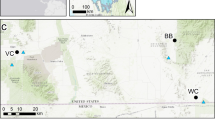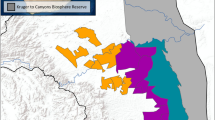Abstract
Construction of the 1913 Los Angeles aqueduct system had a different effect on vegetation productivity, diversity, and stability in the Mojave Desert than did construction of the 1970 aqueduct. Drastic disturbance was found to impede vegetation recovery, whereas slight disturbance sometimes enhanced vegetation. Comparisons of productivity, diversity, and stability measures for both aqueducts show apparent similarities of vegetation cover, biomass, and density. However, these similarities often vanish when one considers qualitative factors, such as proportion of long-lived species and typical cominants of undisturbed communities. Percentage composition of common long-lived perennials represents a good qualitative measure to supplement quantitative comparisons. Enhancement of vegetation along the right-of-way transects of the 1913 aqueduct shows considerable recovery, owing to the more than 65 years that have passed since construction.
Similar content being viewed by others
Literature cited
Bureau of Land Management. 1979.Weight density values for perennial plants of the Colorado and Mojave Deserts, California. Desert Plan Program, Bureau of Land Management, Riverside, California File report.
Hutcheson, K. 1970. A test for comparing diversities based on the Shanon formula.Journal of Theoretical Biology 29: 151–154
Johnson, H. B., F. C. Vasek, and T. Yonkers. 1975. Productivity, diversity and stability relationships in Mojave Desert roadside vegetation.Bulletin of the Torrey Botanical Club. 102: 106–114
Kay, B. L. 1979. Summary of revegetation attempts on the second Los Angeles aqueduct.Mojave revegetation notes, Agronomy and Range Science, University California, Davis No. 22.
Lathrop, E. W. 1979.Plant response studies to utility construction in the Mojave Desert, California. Contract No. Ca-060-CT8-53. Desert Plan Program, Bureau of Land Management, Riverside, California Final report.
McIntosh, R. P. 1967. An index of diversity and the relation of certain concepts to diversity.Ecology 48: 392–404.
Muller, C. H. 1940. Plant succession in theLarrea-Flourensia climax.Ecology 21: 106–115.
Rice, C. M. 1971. Vegetation study of the Los Angeles Aqueduct. Bureau of Land Management, Portland, Ore. File report, looseleaf, 9 pp.
Rice, C. M., and L. Walgren. 1972.Rehabilitation of disturbed arid areas with native desert species in the Mojave Desert. Bureau of Land Management, Bakersfield, California File report.
Sokal, R. R., and F. J. Rohlf. 1969.Biometry. W. H. Freeman, San Francisco.
Vasek, F. C. 1979. Plant succession in the Mojave Desert. In Wright, W. (ed.) California deserts-fragile ecosystems. Symposium proceedings, Southern California Botanists, Rancho Santa Ana Botanic Garden, Claremont, California In press.
Vasek, F. C., H. B. Johnson, and D. H. Eslinger. 1975a. Effects of pipeline construction on creosote bush scrub vegetation of the Mojave Desert.Madrono 23: 1–12.
Vasek, F. C., H. B. Johnson, and G. D. Brum. 1975b. Effects of power transmission lines on vegetation of the Mojave Desert.Madrono 23: 114–129.
Author information
Authors and Affiliations
Rights and permissions
About this article
Cite this article
Lathrop, E.W., Archbold, E.F. Plant response to Los Angeles aqueduct construction in the Mojave desert. Environmental Management 4, 137–148 (1980). https://doi.org/10.1007/BF01866510
Issue Date:
DOI: https://doi.org/10.1007/BF01866510




